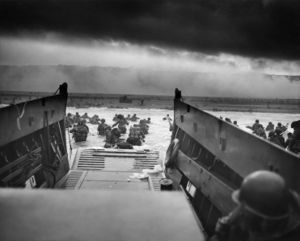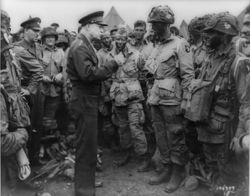Difference between revisions of "What Mistakes did the Allies make during Operation Overlord on D-Day"
| Line 46: | Line 46: | ||
<div class="portal" style="width:85%;"> | <div class="portal" style="width:85%;"> | ||
====Related DailyHistory.org Articles==== | ====Related DailyHistory.org Articles==== | ||
| − | + | {{#dpl:category=World War Two History|ordermethod=firstedit|order=descending|count=12}} | |
| − | |||
| − | |||
| − | |||
| − | |||
| − | |||
</div> | </div> | ||
| + | |||
====References==== | ====References==== | ||
<references/> | <references/> | ||
[[Category:Wikis]] [[Category:World War Two History]] [[Category:United States History]] [[Category:Military History]] [[Category: European History]] | [[Category:Wikis]] [[Category:World War Two History]] [[Category:United States History]] [[Category:Military History]] [[Category: European History]] | ||
Revision as of 17:51, 28 September 2021
June 6, 1944 was arguably the most pivotal day of World War II. Operation Overlord was set to be launched and if successful, was to open a second front in Europe so as to attack Germany from all sides. Stalin’s Soviet Army had been battling the German Army since late 1942 in Stalingrad, Leningrad, and Moscow. Germany was unable to force the Soviets into surrender and Stalin’s troops slowly pushed the Germans back from Russia. The Soviet soldiers defended their motherland honorably; however, they needed a reprieve from the German armor and killing squads sent east to execute and imprison Russian Jews and political prisoners. The Western front Stalin had been insisting upon was finally coming into the realm of reality.
The invasion named Operation Overlord was planned to unfold in three parts; the break-in, the buildup, and the breakout. The first stage was the most dangerous and challenging as the Allied troops were tasked with attacking and holding the beaches of Normandy in the face of an open German assault. The elements of nature seemed to conspire against the Allies and the German defenses, although not optimal, were solid and treacherous. The ultimate detriments to the Allied strategy of the break-in phase; however, were the mistakes made by the Allies themselves.
Airborne Missions
Before the amphibious landing was made, paratroopers from the U.S.101st and 82nd Airborne divisions were tasked with jumping behind enemy lines to secure roads and bridges tactically imperative to the security of Omaha and Utah Beaches. British airborne divisions conducted a similar operation to secure access to the Sword, Gold, and Juno Beaches. The British divisions achieved a greater measure of success than the Americans.
The American Airborne transported its paratroopers via C-47 transport planes, which were neither armed nor armored. These aircraft and their crews had no means by which to defend themselves once the German anti-aircraft guns began to fire. Further, since they were not armor-plated, due to weight, being hit by flak or shrapnel in an engine or fuel tank was catastrophic for the aircraft and crew. After the tight V formation of planes crossed the English Channel, German guns opened fire and immediately began to cause irreparable damage to the 101st and 82nd aircraft.[1]
The American C-47 pilots were relatively inexperienced in combat flying. The lack of experience, combined with the fact that the crews were ordered to fly under radio silence, compounded an already perilous situation. Some of the pilots ordered the jump too soon while others waited too long. As a result of the ill-timed jumps, scores of paratroopers were dropped at an altitude too low for success.
Many were dropped at sea while others jumped into flooded fields. Other companies jumped into heavily defended towns and were either shot down while descending or captured once they hit the ground. Some paratroopers never got to jump at all as several aircraft were damaged in flight to the extent that they crash-landed or exploded while still in flight; the aircraft carrying their crews and full complements of paratroopers were casualties of war. One such aircraft crashed into a hedgerow and immediately burst into flames.
This plane carried the headquarters company for Easy Company; E Company, 2nd Battalion, 506th Parachute Infantry Regiment, 101st Airborne Division. Easy Company's recently installed leader, 1st Lieutenant Thomas Meehan, was killed instantly. Command of Easy Company fell to 1st Lieutenant Richard Winters. He and his fellow paratroopers were unaware of Meehan's fate upon landing in France.[2]
Once safely on land, the men of the 101st and 82nd were scattered haphazardly throughout the French countryside. In the dark, these men had to blindly navigate the terrain after having lost maps and compasses during the drop. Some paratroopers lost everything they had packed into their leg bags, which blew off immediately once they exited the aircraft; that meant no map, compass, weapon, food, or ammunition. With as much stealth as possible, the troopers slowly connected with others who were lost and made their way to the rendezvous point. Because of the heavy casualties and dramatic delays due to the inaccurate drops, their missions were minimally accomplished, which meant that the amphibious landings took place without the benefit of the German communications and access to the beaches being cut.
Pointe du Hoc
The first stage of the attack was carried out at a high bluff called Pointe du Hoc, located between Utah Beach to the west and Omaha Beach to the east. Three U.S. Army Ranger companies were tasked with capturing the battery of 155mm guns housed in a casement at the top of the cliff. This mission was ordered as a first step to the invasion so as to prevent the Germans from opening fire on the soldiers who were to land on Omaha and Utah.Unfortunately, due to choppy seas and German defenses, the landings suffered a significant forty-minute delay. German artillery sunk one of the ten Allied transport vessels, which resulted in the drowning deaths of all but one man. The Rangers finally reached the base of the cliff of Pointe du Hoc at 0710 hours.[3]

The landing craft was equipped with rocket launchers that propelled grapnels and ropes up the sheer cliff for the men to ascend to the top. Under German fire, these soldiers suffered heavy casualties and fought their way to the top. Once reaching the plateau, they found that their objective, the guns, had been moved. Patrols were deployed, and five of the projected six guns were found, and their firing mechanisms destroyed.
Of the nearly three hundred Rangers deployed in the first assault group, 150-200 were either wounded or killed in action. The second wave of Rangers, an additional 500 men, was awaiting the signal flare to join the attack.[4]Due to the initial forty-minute delay, the flare was fired too late, and the additional Rangers had joined the invasion at Omaha Beach.
Omaha Beach
The showdown at Omaha pitted the U.S. 1st Division against the 352nd of Germany. This beach was comparatively narrow and culminated in a steep, fortified bluff. At the base of the bluff, the Americans faced a swampy sea wall and an anti-tank ditch the Germans had constructed. Adding to the natural and German-made obstacles, the Americans faced their problems. The Navy launched the landing craft too far out in the channel; as the sea was choppy this resulted in a heavy loss of men and equipment due to capsized vessels.[5]
Further, as the previous airborne mission failed to meet its objective, the troops landing on Omaha were very vulnerable. They fell in an unorganized fashion, and a tremendous number of the first wave were killed before exiting the craft. German defenders were firing unhindered from the bunkers and casements atop the bluff, and the American G.I.s were out in the open. The only chance for the cover was to reach the base of the bluff. Men lost their weapons during the landings and dodged behind the wooden obstacles Marshall Rommel had constructed. They were also forced to duck behind the dead bodies of their comrades. The Navy bombardment had little effect on the German guns, and initially, Rommel’s defense was holding; however, the German commander feared his line would become untenable.
Once the invasion began, the German command acted with confusion. They believed that the weather would delay the Allied invasion for a month. Additionally, even after the landings were initiated at Normandy, Field Marshal Rundstedt still held that the primary target was Pas de Calais. Rommel was certain that this attack on Normandy was, in fact, the primary objective of the Allied plan. He requested that all available Panzer divisions be sent immediately to Normandy in addition to infantry being held in reserve. Rundstedt, who had convinced Hitler that Calais was the target, refused Rommel’s request without first speaking to the Führer. He called Hitler to request permission to move two Panzer divisions to Normandy. Hitler was sleeping. No member of Hitler’s staff had the nerve to wake him, which resulted in a twelve-hour delay in moving the tanks.[6]
Conclusion
The delay by Germany afforded the Allied troops ample time to secure the beaches of Normandy on the first day of the invasion. By the end of the day, the Americans were able to get off of Omaha Beach, although the cost was great. When the fighting on June 6 was done for the night on Omaha, the U.S. suffered more than 2,000 casualties. In the entirety of the first day of attack, across all of the beaches, including the Airborne divisions, Navy, and landing troops, the Allies employed more than 150,000 men.[7]The Americans on Utah beach were also successful with far fewer casualties, yet the movement was equally slow. The British and Canadian forces held Gold, Juno, and Sword but went no further on the first day. The next goal for the Allies was to build-up forces on the ground and to take strategically important towns that would eventually lead to the breakout and ensuing march to Berlin.
Related DailyHistory.org Articles
- How did Mussolini Rise to Power as the Dictator of Italy
- Why did Germany lose the Battle of Stalingrad
- What were Joseph Stalin's goals as World War Two ended
- How did World War II Lead to the Cold War
- How historically accurate is the movie Hurricane (aka Mission of Honor)
- Why did Japan attack Pearl Harbor in 1941
- Why did the Mukden Incident lead to the creation of the Stimson Doctrine in 1932 by the United States
- What happened at the "Big Three" conferences between the Allies during World War II
- Why did the United States ally with the Soviet Union during World War II
- What was Lend-Lease and how did it provide Aid to US Allies at the start of World War II
- Why was Los Alamos created by the Manhattan Project
- What was Blitzkrieg and Who Created it
References
- ↑ Stephen Toth, "Total War and Crisis" (lecture, Arizona State University, Glendale, November 17, 2011).
- ↑ Stephen Ambrose, "Band of Brothers: E Company, 506th Regiment, 101st Airborne from Normandy to Hitler's Eagles Nest" (1992, New York: Simon & Schuster, 2001), 69. To support Ambrose, see Richard Winters and Cole C. Kingseed, "Beyond Band of Brothers: The War Memoirs of Major Dick Winters" (New York: Berkly Books, 2006).
- ↑ Michael J. Lyons, World War II: A Short History, 5th ed. (Upper Saddle River, NJ: Prentice-Hall, 2010), 250.
- ↑ Tothe, Lecture.
- ↑ Lyons, 251.
- ↑ Lyons, 249-50.
- ↑ Toth, Lecture.




